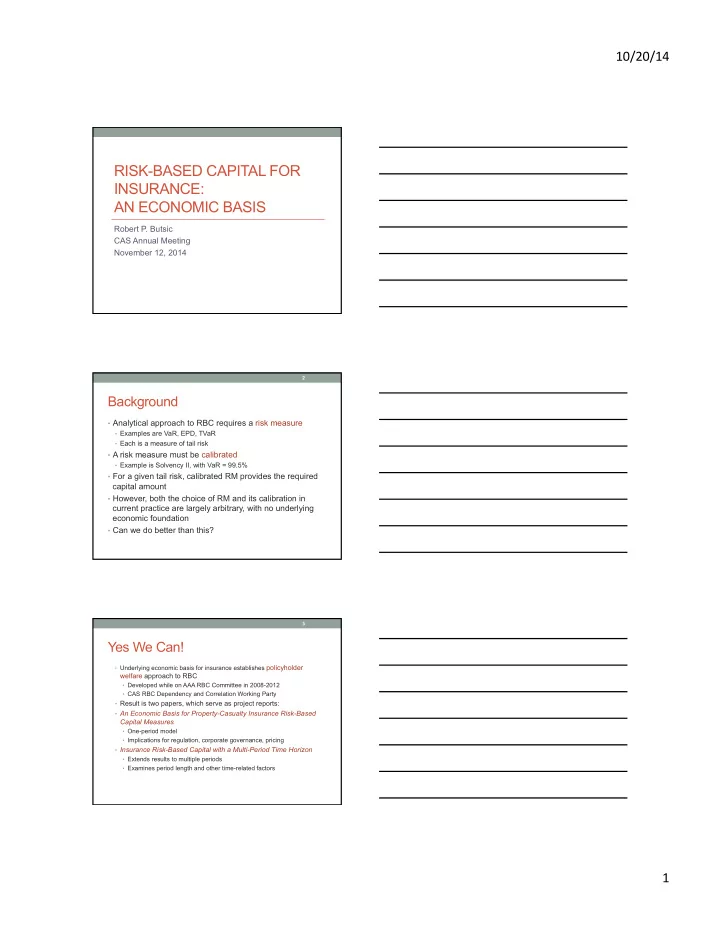

10/20/14 ¡ RISK-BASED CAPITAL FOR INSURANCE: AN ECONOMIC BASIS Robert P. Butsic CAS Annual Meeting November 12, 2014 2 Background • Analytical approach to RBC requires a risk measure • Examples are VaR, EPD, TVaR • Each is a measure of tail risk • A risk measure must be calibrated • Example is Solvency II, with VaR = 99.5% • For a given tail risk, calibrated RM provides the required capital amount • However, both the choice of RM and its calibration in current practice are largely arbitrary, with no underlying economic foundation • Can we do better than this? 3 Yes We Can! • Underlying economic basis for insurance establishes policyholder welfare approach to RBC • Developed while on AAA RBC Committee in 2008-2012 • CAS RBC Dependency and Correlation Working Party • Result is two papers, which serve as project reports: • An Economic Basis for Property-Casualty Insurance Risk-Based Capital Measures • One-period model • Implications for regulation, corporate governance, pricing • Insurance Risk-Based Capital with a Multi-Period Time Horizon • Extends results to multiple periods • Examines period length and other time-related factors 1 ¡
10/20/14 ¡ 4 A Basic Economic Tradeoff • More capital is better for policyholders • But capital is costly, so insurer can’t hold too much of it • Thus, in principle, there must be an optimal capital amount • How do we find the optimal amount? • Do we need to specify a risk measure? • Or is the risk measure determined by the underlying economic assumptions? • The key notion is how we value insurance • We can value complete protection from loss • Use same method to determine value the unprotected loss from insurer default 5 The Value of Insurance • Fundamental basis of insurance: policyholders are risk-averse • Therefore, they will pay more than expected value for coverage • The difference is the consumer value (consumer surplus) • Risk-aversion can be quantified by an adjusted probability distribution • This formulation is the dual process for expected utility • The expected loss under the APD is called the certainty-equivalent loss ( L ^) • The CEL is the maximum the PH will pay for coverage • If the insurer charges the expected loss ( L ), the CV is L ^ – L 6 Optimal Capital Amount • One-period model with no expenses, inv. income, etc. • Value of insurance contract is V = CEL – premium – CE value of default • Premium = L + zC , where z is frictional capital cost rate • The premium compensates owners fairly • Both policyholders and insurer’s owners are satisfied • As C increases, premium goes up, but CED goes down • So, there is an optimum value for C , obtained by the derivative of the insurance value V • Example next 2 ¡
10/20/14 ¡ 7 Optimal Capital Example 100 80 60 40 Consumer Value 20 0 0 100 200 300 400 500 600 700 800 900 1000 -20 -40 Capital 8 The Proper Risk Measure • Optimum occurs when the adjusted ruin (default) probability Q ^ equals z • Q ^ is the proper risk measure • It is not arbitrary – it follows directly from the economic basis for insurance • The calibration is not arbitrary; it equals z • The FCC rate is essentially the cost of double taxation • The proper risk measure is none of the conventional RMs • These RMs (VaR, EPD) give too little weight to extreme tail loss amounts • They do not consider the PH risk aversion to these events • The subadditivity constraint (a coherent RM property) for RMs is unnecessary 9 Implications for RBC • Regulatory RBC will depend on optimal capital, but will be a lesser amount • Several factors/variables not currently considered are important: • Individual behavior: risk aversion • Economic : interest rate • Government: guaranty fund participation, income tax rate • Asset risk is modeled in same way as losses • Consumer value for asset risk is negative • Adjusted asset return is the risk-free rate 3 ¡
10/20/14 ¡ 10 RBC for Multiple Periods • Debate over basis for multi-period RBC • Runoff approach uses ultimate loss volatility • Annual approach uses current year loss volatility • Extend one-period model to more periods by incorporating • Stochastic loss development process • Dynamic capital funding strategy • Effect of technical insolvency and conservatorship • Cost of raising external capital • Backward induction method extends model beyond two periods 11 Results for Multi-period Model • Optimal capital for multiple periods depends on both annual and ultimate time horizons • Losses develop to ultimate under conservatorship • Thus, optimal capital amount is greater than under annual method • Optimal capital increases with horizon length • Capital-raising costs also increase initial optimal capital • A shorter period length (capitalization interval) reduces optimal capital amount • Ability to raise and withdraw capital quickly reduces need for it • Access to capital markets is an important factor in determining optimal capital for an insurer 12 Concluding Remarks • Main purpose is to further our understanding of how to establish risk-based capital for insurance losses and assets • Lots of work ahead to implement this analysis • Need research on risk preferences • Simulation models ideally suited • Nevertheless, qualitative results can be used; examples • Compared to conventional risk measures: more capital is needed for high-risk losses less capital is needed for low-risk losses • Lines of business with more guaranty fund coverage require less capital • Insurers with limited ability to raise capital (e.g., small mutuals) need more RBC than large stock insurers 4 ¡
Recommend
More recommend